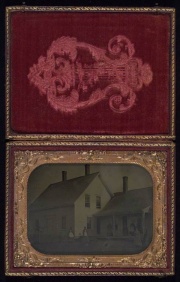Ambrotype
Jump to navigation
Jump to search
Description
An early type of photograph developed by Frederick Scott Archer in 1851. Ambrotype, popular from 1850-1870, is a direct-positive method of photography prepared by imaging a wet collodion negative on a glass plate. Originally, the plate was reversed and shown in reflected light while the image side was covered with a black varnish or black paper. Later versions used the double glass process in which the plate was not reversed but rather a backing was applied to the reverse side of the plate while a spacing mat and cover glass were added to the front (image) side. Ambrotypes have a fragile surface and the images were usually sealed in a metallic frame or case.
Additional Images
Resources and Citations
- SAA: Glossary of Archival Terminology: http://www.archivists.org/glossary/term_details.asp?DefinitionKey=2470 - gives ".. patented in 1854 by James Ambrose Cutting "
- Luis Nadeau, Encyclopedia of Printing, Photographic, and Photomechanical Processes, Atelier, New Brunswick, 1997 Comment: Frederick Scott Archer in 1851
- Caring for your Collections, Arthur W Schulz (ed.), Harry N. Abrams, Inc. , New York, 1992
- Van Nostrand's Scientific Encyclopedia, Douglas M. Considine (ed.), Van Nostrand Reinhold, New York, 1976
- Random House, Webster's Encyclopedic Unabridged Dictionary of the English Language, Grammercy Book, New York, 1997
- Wikipedia: http://en.wikipedia.org/wiki/Ambrotype (Accessed Mar. 15, 2006)


